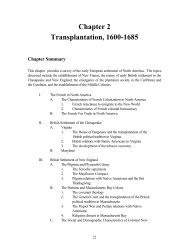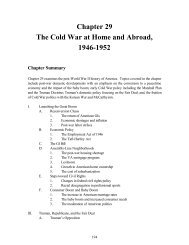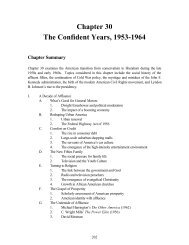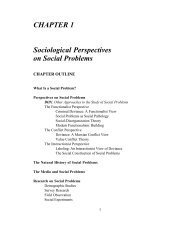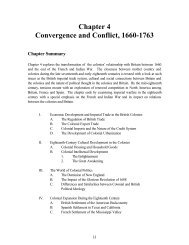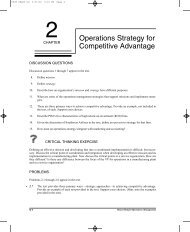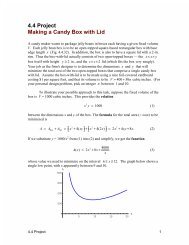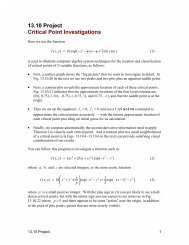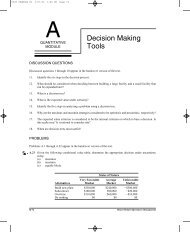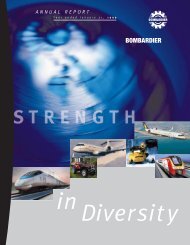4 A POLYCENTRIC WORLD 1700 B.C.E. ? 1000 C.E.
4 A POLYCENTRIC WORLD 1700 B.C.E. ? 1000 C.E.
4 A POLYCENTRIC WORLD 1700 B.C.E. ? 1000 C.E.
You also want an ePaper? Increase the reach of your titles
YUMPU automatically turns print PDFs into web optimized ePapers that Google loves.
4 A <strong>POLYCENTRIC</strong> <strong>WORLD</strong><br />
<strong>1700</strong> B.C.E. – <strong>1000</strong> C.E.<br />
COMMENTARY<br />
CITIES AND STATES IN EAST ASIA, THE AMERICAS,<br />
AND WEST AFRICA<br />
Chapter 4 concludes the second section of the book (Settling Down) with a comparative survey of the final four<br />
of the seven “primary innovative” urban civilizations identified in the second chapter: (1) those of the Yellow River<br />
valley in China; (2) the urbanized societies of Mesoamerica; (3) civilizations of the Peruvian coastal areas and the Andes<br />
Mountains in South America; and (4) the earliest urban civilizations of the Niger River Valley in west Africa. The<br />
common denominator of all these urban societies is that they developed considerably later than those of Mesopotamia,<br />
Egypt, or the Indus Valley. Urbanization and state formation apparently did not begin in China until Sumerian city-states<br />
and the Old Kingdom of Egypt were at their respective zeniths (c. 2200 B.C.E.) and did not begin for another thousand<br />
years in the Americas (c. 1200 B.C.E.) and yet another millennium or more in west Africa.<br />
Several of these civilizations also “stretch our definition of urbanization,” according to Spodek (p. 86), for, while<br />
all of them exhibited most of the standard features of cities he enumerated in Chapter 2, there were significant exceptions.<br />
All, of course, had evolved from earlier agricultural settlements. All exhibited considerable occupational specialization<br />
and professionalization. City-states developed in all areas and some extended their control over large agricultural and<br />
trading regions. And all appeared to have served as important religious and cultural centers, as well as administrative<br />
capitals and commercial entrepots. In the Americas, however, neither metal tools nor wheeled vehicles ever-developed,<br />
and only the Maya ever developed a system of writing. Even large draft animals such as the horse or ox or water buffalo<br />
were lacking, thus making transportation, construction and agriculture much more labor intensive than it was in the<br />
eastern hemisphere. Similarly, the inhabitants of Jenne-Jeno and other west African city-states never developed an<br />
indigenous writing system and, while they did possess iron tools, wheeled carts and draft animals, they were not used to<br />
build any of the monumental temples, tombs, and palaces or sophisticated irrigation and flood-control systems associated<br />
with cities in all of the other areas. Moreover, African cities do not appear to have exhibited the high degree of social<br />
stratification and unequal distribution of wealth so characteristic of those in Mesopotamia, Egypt, China and the<br />
Americas, nor was their power and influence based as much on their control over territory and their function as religious<br />
shrine centers, as it was on their domination of important trade routes.<br />
A second theme that is stressed throughout the chapter is the importance of cities as “cosmo-magical” centers,<br />
or locations for important religious rituals, often those which served to demonstrate and strengthen the identification of<br />
“shaman priest-rulers” as intermediaries between their people and deities or deceased ancestors. Hence the importance<br />
of royal tombs in China (as in Egypt) and the construction of monumental temples, statues, and pyramids in Mesoamerica<br />
(as in Sumerian, Egyptian and Harappan cities). Only in west Africa was this not a central feature of urban development.<br />
There were also significant differences in the connection and interaction among cities in the different areas. As<br />
was the case with the city-states of Sumer, the Xia, Shang, and Zhou states of China and the major Mayan cities<br />
(Palenque, Tikal, Uxmal, Chichen Itza) shared a common culture, language and religion and evolved more or less on<br />
parallel lines with one another for centuries. In other parts of Mesoamerica, in South America and in west Africa,<br />
separate urban societies evolved, with different languages, economies and traditions; connected at times by trade but<br />
never consolidating, unless they were conquered by an imperial power, such as the Aztecs or the Incas.<br />
What these comparisons suggest, perhaps, is that “urbanization” – like “civilization” – should not be<br />
understood as an immutable model or a term of measurement of a people’s “progress” or development, but like “culture”<br />
is a term referring to the interaction of a society with its environment. Different physical environments produce different<br />
types of cities: people have to work with what they have, or can trade for.<br />
16
CHAPTER OUTLINE<br />
A. Introduction: Cities and States in East Asia, the Americas, and West Africa<br />
B. China: the Xia, Shang, and Zhou Dynasties<br />
1. Earliest times: How Do We Know?<br />
a. Texts<br />
b. Oracle bones<br />
c. Archaeology<br />
2. Earliest times: What Do We Know?<br />
a. The earliest villages<br />
b. Historical evidence of the Xia dynasty<br />
c. Similarities among the three dynasties<br />
3. City and state under the Shang<br />
a. The nature of the Shang state<br />
b. Anyang, the last Shang capital<br />
c. FOCUS: the Cosmo-Magical City<br />
C. The Western Hemisphere: Mesoamerica and South America<br />
1. Urbanization in East Asia and the Americas: similarities and differences<br />
2. Origins, migration and agriculture<br />
3. Mesoamerican urbanization<br />
a. Olmec civilization along the Gulf Coast<br />
b. Zapotec civilization in the Oaxaca Valley<br />
c. Teotihuacan in the Valley of Mexico<br />
d. Toltec civilization in the Valley of Mexico<br />
e. Aztec civilization in the Valley of Mexico<br />
f. Maya civilization: How Do We Know?<br />
g. SOURCE: the Popul Vuh (p. 101)<br />
h. Maya civilization: What Do We Know?<br />
i. PROFILE: Great-Jaguar-Paw, Mayan King of Tikal (pp. 106-107)<br />
4. FOCUS: Agricultural Towns of North America (p. 102)<br />
5. Urbanization in South America<br />
a. Comparisons and contrasts with Mesoamerica<br />
b. Coastal settlements and networks<br />
i. The Moche<br />
ii. The Chimu<br />
iii. SPOTLIGHT: The Royal Tombs at Sipan (pp. 108-109)<br />
b. Urbanization in the Andes Mountains<br />
i. The Chavin<br />
ii. Tiwanaku, Huari, and Nazca<br />
iii. The Inca<br />
D. West Africa: the Niger River Valley<br />
1. Introduction: questions about the origins and function of the earliest West African cities<br />
2. West Africa before urbanization: Nok iron-smelting and Bantu agriculture<br />
3. Jenne Jeno: How Do We Know?<br />
a. Age, size, layout and purpose of “ancient Jenne”<br />
b. Which came first: West African cities, or trans-Saharan trade?<br />
4. State formation?<br />
a. Did Jenne-Jeno represent an alternative kind of urbanization?<br />
b. Or did it represent a stage in conventional urban development?<br />
E. The First Cities: What Difference Does it Make?<br />
17
IDENTIFICATION TERMS<br />
For each term, students should be able to provide an identification or definition, an approximate date, a geographical<br />
location (if relevant) and – most important – a concise explanation of its significance in the context of the chapter. Terms<br />
that appear in the Study Guide are listed in bold font in the first column.<br />
Jenne-Jeno Shang Dynasty Great-Jaguar-Paw<br />
Xia Dynasty Yellow River (Huang Ho) Toltecs<br />
Tikal Zhou Dynasty Cahokia<br />
Moche Yangshao Culture Chavin<br />
trans-Saharan trade Longshan Culture Sipan<br />
chinampas Valley of Mexico Andes Mountains<br />
oracle bones La Venta Niger River<br />
Teotihuacan Zapotecs Nok Culture<br />
Anyang Maya Bantu<br />
Olmecs The Popul Vuh Timbuktu<br />
LEARNING OBJECTIVES<br />
After students have read and studied Chapter 4, they should be able to:<br />
1. Describe and explain the geographical and economic factors contributing to urbanization in the earliest cities in<br />
China, the Americas and West Africa.<br />
2. Explain the role of religion in those early civilizations and its relationship to urbanization and state formation.<br />
3. Be able to explain and compare the different patterns of state formation in China, the Americas and West Africa, and<br />
to discuss the controversies surrounding the question of state formation in the latter.<br />
4. Give specific examples of how archaeological evidence can be used to illustrate and explain the existence of class<br />
systems in ancient cities.<br />
5. Be familiar with the various theories of the origins of Olmec and other civilizations in the Americas, and with the<br />
questions pertaining to the downfall of Teotihuacan and of Mayan civilization.<br />
SUGGESTIONS FOR LECTURE TOPICS<br />
1. Discuss Paul Wheatley’s thesis concerning cities as “cosmo-magical centers” and use it to compare cities in early<br />
China and Mesoamerica with those in Mesopotamia and Egypt.<br />
2. Discuss the development of metallurgy – and iron-smelting in particular – in ancient cultures and relate it to issues of<br />
“innovation” vs. “diffusion” in early African history.<br />
3. Explain the evidence for the existence of social classes in the various societies and discuss their relationship to<br />
political structures, agricultural methods, organized religion and warfare.<br />
4. Discuss the role of climate and topography in the different civilizations reviewed in Chapter 4.<br />
TOPICS FOR ESSAYS OR CLASS DISCUSSION<br />
1. What characteristics did all of the cities described in Chapter 4 have in common? In what important respects did they<br />
differ from one another?<br />
2. Describe the powers, responsibilities and functions of Xia, Shang, and Chou dynasty rulers. How did they attain<br />
their positions? What was expected from them by their subjects? How would the term “cosmo-magical” be applied<br />
to them?<br />
18
3. Compare the functioning of the Shang dynasty state in China (1766-1122 B.C.E.) with that of the later Inca Empire in<br />
South America (1476-1534 C.E.) How were the states formed? How were they governed? What was the relationship<br />
between the ruler and the official religion if the state?<br />
4. How might one account for the comparatively slow development of urbanized societies and the lack of such basic<br />
attributes of urban civilization as metal tools, wheeled vehicles and a written language in most societies of the<br />
Americas, even as late as the arrival of Europeans, c. 1500 C.E.?<br />
5. Debate: Were the population concentrations that developed in Jenne-Jeno and other urbanized sites in West Africa<br />
true urban civilizations, like those of China, Egypt and Mesopotamia? Why or why not? And what does this<br />
controversy possibly reveal about such terms as “urbanization” and “civilization” – not to mention attitudes towards<br />
early African history?<br />
6. In addition to the urban civilizations of Central and South America, extensive evidence of agricultural settlements has<br />
been unearthed at numerous sites in North America. Where were these settlements located? Citing specific examples<br />
and evidence, explain the ways in which these settlements demonstrated the “urban” characteristics of their<br />
southern counterparts and other urban societies. Why do many scholars argue that these were not fully urbanized<br />
civilizations?<br />
7. Group activity: Compare the Mayan creation myth related in the Popul Vuh with the Hebrew creation myth found in<br />
the book of Genesis, the Indian creation myth in the Rigveda and the Akkadian Enuma Elish (pp. 5-6). In what<br />
respects are they similar? Different? What does each myth reveal about its culture’s concepts of the relationship<br />
between humans and their gods or God? [The Japanese, Greek and Inca myths in Chapter 1 of the Documents Set<br />
and the Fang creation myth in the prenhall.com web-site may also be used.]<br />
TEXT RESOURCES (Spodek, 2 nd ed.)<br />
Timetables, charts and graphs: Early China (p. 87)<br />
Early Chinese Culture (p. 90)<br />
The Early Americas (p. 94)<br />
Civilizations Flourishing in Central America Before (p. 105)<br />
Columbus<br />
Civilizations of South America (p. 110)<br />
Early Africa (p. 112)<br />
Large photographs or illustrations: Inscribed oracle bone, China (p. 88)<br />
Teotihuacan, Mexico (p. 99)<br />
Blood-letting rite, Mexico (Maya) (p. 103)<br />
Temple at Tikal, Guatemala (Maya) (p. 104)<br />
Pirogues, Niger River (p. 114)<br />
Maps: Shang China (p. 89)<br />
Classic cultures of the Americas (p. 96)<br />
Teotihuacan (p. 98)<br />
The spread of Bantu (p. 113)<br />
Trade across the Sahara (p. 115)<br />
SPOTLIGHT: The Royal Tombs of Sipan (p. 108-109)<br />
PROFILE: Great-Jaguar-Paw (p. 106)<br />
FOCUS: The Cosmo-Magical City (pp. 92-93)<br />
Agricultural Towns of North America (p. 102)<br />
SOURCE: The Popul Vuh (p. 101)<br />
19
ADDITIONAL PRIMARY SOURCES (Documents Set & www.prenhall.com/Spodek)<br />
4-1 “Shih ching”: a glimpse into the mind of China during its legendary phase [The Book of Songs]<br />
4-2 Might makes right: the “Shu ching” sets forth the Mandate of Heaven [The Book of Historical Documents]<br />
4-3 Ch’u Yuan and Sung Yu: individual voices in a chaotic era<br />
4-4 “Wagadu”: the Soninke epic of ancient Ghana<br />
4-5 Sundiata: the Malian epic of an empire-builder<br />
4-6 The Mesoamerican mind: Tezcatlipoca, Quetzalcoatl, and music<br />
4-7 The Mesoamerican mind: the Aztecs and holy warfare<br />
www Mwindo: the “Little-one-just-born-he-walked”<br />
AUDIO-VISUAL RESOURCES (videos, DVD’s, CD-ROM and web-sites)<br />
The Civilization of the Olmec: http://loki.stockton.edu/~gilmorew/consorti/1bcenso.htm [web-site]<br />
Interprets the evidence for the origins, history and legacy of the Olmecs, based on archaeological sources.<br />
The Incas: PBS Home Video. [video; 60 minutes, color]<br />
Comprehensive interpretation of Inca civilization.<br />
Legacy: Ambrose Video Publishing Co., 1991. [video; 57 minutes, color]<br />
Part of a six-video series that explores the influence of ancient cultures on our lives today.<br />
Lords of the Earth: Maya/Aztec/Inca Exchange: http://www.realtime.net.maya/ [web-site]<br />
Surveys the history, art and culture of the three great pre-Columbian civilizations of the Americas.<br />
The Maya: Lords of the Jungle: PBS Home Video. [video; 60 minutes, color]<br />
Comprehensive survey of Mayan civilization.<br />
Mayan Civilization, Past and Present: http://indy4.fdl.cc.mn.us/~isk/maya.html [web-site]<br />
This site is a search engine, linking viewers to a number of different Maya web-sites.<br />
The Mystery of the Maya: http://www.cmcc.muse.digital.ca/membrs/civiliz/maya/mminteng.html [web-site]<br />
A comprehensive exhibit of Mayan sources and artifacts.<br />
Out of the Past: Annenberg/CPB. [eight 60 minute videos; color]<br />
This series is a topically-arranged survey of aspects of ancient world civilizations and their legacies in the<br />
modern world. Sumer, Egypt, India, China, and African and American civilizations are included in videos that<br />
focus on origins, families, religion, warfare, trade, government, symbols and other topics.<br />
Wonders of the African World, with Henry Louis Gates, Jr.: PBS Home Video, 2000. [3 videos; 360 min, color]<br />
Gates explores Africa from Egypt to Great Zimbabwe and Kenya to the Atlantic. Excellent segments on the<br />
Malian cities of Jenne-Jeno and Timbuktu.<br />
20



